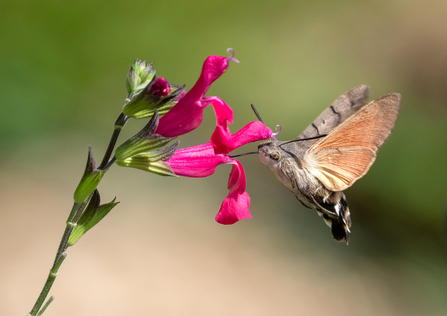
Hummingbird hawk-moth by Colin Lamb
Hop flowers growing in the sun. Picture: Jon Hawkins/ Surrey Hills Photography

Hummingbird hawk-moth by Colin Lamb
Hummingbird hawk-moths are named for their resemblance to a hummingbird as they hover (audibly) to feed on flowers before darting to the next. They prefer to feed on plants with long flowers like viper’s-bugloss, red valerian, honeysuckle or buddleia, so keep an eye out if you have any of these in your garden.
Hummingbird hawk-moths fly during the day, so, if you do see them in your garden, keep a regular watch as they’re known to return to the same flowerbeds at the same time of day to feed.
This stunning picture, taken by Colin Lamb, was one of last year’s winners for our Wildlife Photography Competition. This year’s contest is open for entries until 26 August, so as you enjoy the summer wildlife, why not send us your best snaps?
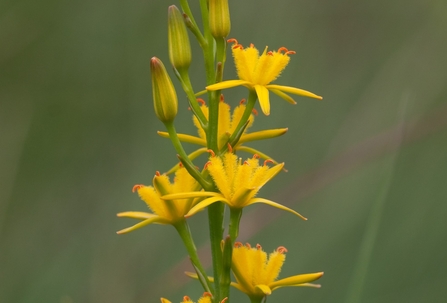
Bog asphodel by Vaughn Matthews
As the name suggests, bog asphodel grows in damp, boggy areas and can be seen at heathland reserves including Inkpen Common and Snelsmore Common. The tall spikes of yellow flowers bloom in summer, and later in the year most of the plant will turn orange in colour as it produces reddish, egg-shaped fruits.
Rabbit by Logan Walker
Who doesn’t love spotting rabbits hopping through long grass during a walk in the countryside? They were first introduced to the UK by the Normans for food and fur but are now a common sight for many.
Female rabbits, called ‘does’, produce one litter of between three and seven babies every month during the breeding season from January to July – that’s a lot of little ones to see this month!
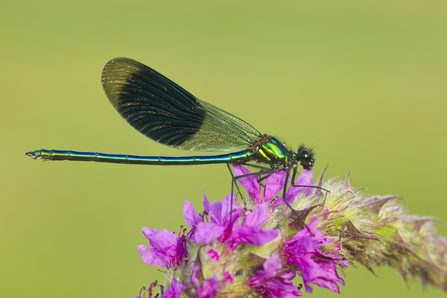
Banded demoiselle at rest - Mark Hamblin/2020VISION
Banded demoiselles are one of the easiest damselflies to identify with their distinctive dark bands on their wings. Look for them flitting by slow-moving streams and rivers as well as ponds and lakes.
The males are metallic blue, with a distinctive dark band across their wings (above), and the females are a shiny green.
A simple tip to know if you're looking at a damselfly or dragonfly is that damselflies tend to hold their wings closed along their backs when at rest, while dragonflies hold their wings out away from their bodies.

7-spot ladybird larva © Vaughn Matthews
Just like adult ladybirds, ladybird larvae are a gardener's friend, feeding on aphids. The larva above is of a 7-spot ladybird, but there are many others you might see too. They all form a pupa – just like a caterpillar does to become a butterfly – before the adult ladybird emerges.

Stoat kittens - or 'kits' - playing. Picture: Tom Hibbert
Stoats usually mate in August, but females don't give birth until the spring, so this is a good time of year to look out for their tiny kits.
After the young leave the den, the family usually stay together for some time, hunting and playing. The mother defends her family fiercely, so don't get in their way! Look out for stoat families in rural grassland, scrubby areas or woodlands such as Little Linford Wood.

Hop flowers growing in the sun. Picture: Jon Hawkins/ Surrey Hills Photography
One of the most magnificent plants is the humble hop, the flowers of which are used to make beer the world over.
These rambling, wild plants can be found all across our area - look out for their long vines scrabbling up other trees and bushes in roadside hedgerows. If you've never smelt a fresh hop flower, treat yourself to the extraordinary fragrance which is a tiny explosion of pungent lemon and garlic.
Purple emperor by Tom Hibbert
Look closely at the tree tops in woodland nature reserves, including Rushbeds Wood and Warburg Nature Reserve, to see if you can catch a glimpse of a purple emperor. These butterflies feed on honeydew, a sweet liquid produced by aphids, or sap from oak trees.
You may be lucky to see a male, which has a purple sheen to its wings, come to the ground to feed on moisture and salts found in puddles and animal dung.

A chicken of the woods fungus (Laetiporus sulphureus) growing on the trunk of a tree. Picture: Vaughn Matthews
While you’re at Warburg, look out for this special species which sounds like it should be a bird, but is actually a bright yellow bracket fungus that sprouts out the side of mature trees.
It gets its common name from the fact that some people say it has a similar texture to chicken when eaten. It doesn't agree with everyone so we don't recommend it, but there are numerous species which rely on it, including some specialist beetles which only feed on bracket fungi.
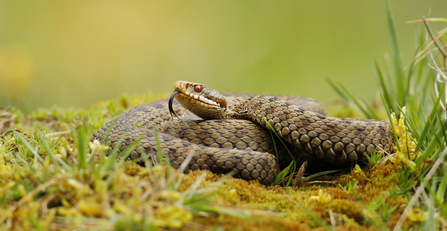
Adder basking on the mossy ground by Jon Hawkins
One of the most striking wild sights of the summer in our area is the awesome adder. These superb snakes, our only venomous species in the UK, are actually shy and retiring creatures, and you’ll be lucky to spot one.
Look out for them basking in quiet, sunny spots among the heather at Greenham and Crookham Commons where we’ve pioneered our Adder Connections project to link up the populations on the site, and also at Padworth Common. If you do see one, just keep a respectful distance - they're much more scared of humans than we are of them!
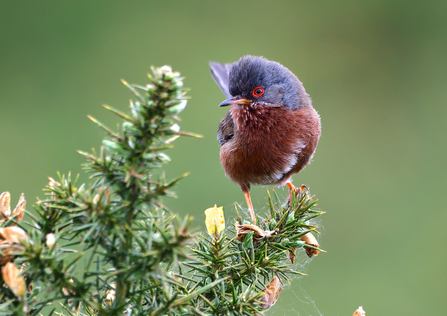
Dartford warbler by Darren Prestoe, Greenham Common Nature Reserve, Berkshire
While you're at Greenham Common, another wonderful species to look out for is the iconic Dartford warbler – the lovely specimen above is another winning entry from last year’s Photography Competition, courtesy of Darren Prestoe.
This small, slate and russet brown song bird, with its striking red eye, depends on mature heathland habitat which we don't have a lot of in England: in the 1960s, there were only 10 pairs left in the UK. Today, there are about 3,200 pairs, and we are honoured to have them at Greenham. Look out for them warbling their rattly and scratchy song from the top of gorse bushes.